Gigabyte GA-MA78LMT-US2H (rev.1.1), GA-MA78LMT-US2H (rev.1.3), GA-MA78LMT-US2H (rev.3.4), GA-MA78LMT-US2H (rev.3.5) User Manual [ru]
GA-MA78LMT-US2H
AM3 socket motherboard for
AMD Phenom™ II processor/ AMD Athlon™ II processor
User's Manual
Rev. 3401
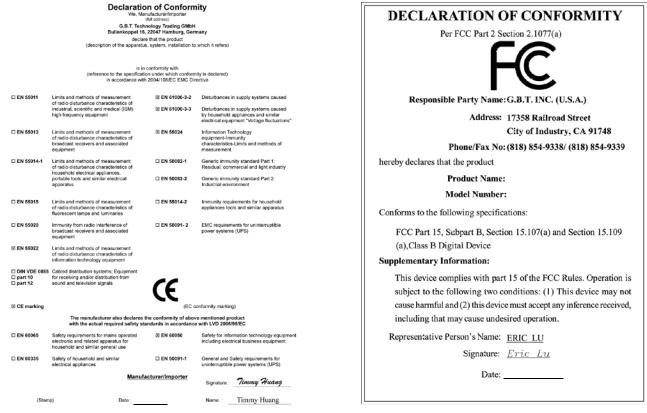
dr aobr eht o M
GA-MA78LMT-US2H
Motherboard
GA-MA78LMT-US2H
Dec. 18, 2009
Dec. 18, 2009
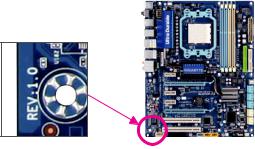
Copyright
© 2009 GIGA-BYTE TECHNOLOGY CO., LTD. All rights reserved.
The trademarks mentioned in this manual are legally registered to their respective owners.
Disclaimer
Information in this manual is protected by copyright laws and is the property of GIGABYTE.
Changes to the specifications and features in this manual may be made by GIGABYTE without prior notice. No part of this manual may be reproduced, copied, translated, transmitted, or published in any form or by any means without GIGABYTE's prior written permission.
Documentation Classifications
In order to assist in the use of this product, GIGABYTE provides the following types of documentations:
For detailed product information, carefully read the User's Manual.
For instructions on how to use GIGABYTE's unique features, read or download the information on/from the Support&Downloads\Motherboard\Technology Guide page on our website.
For product-related information, check on our website at:
http://www.gigabyte.com.tw
Identifying Your Motherboard Revision
The revision number on your motherboard looks like this: "REV: X.X." For example, "REV: 1.0" means the revision of the motherboard is 1.0. Check your motherboard revision before updating motherboard BIOS, drivers, or when looking for technical information.
Example:

Table of Contents
Box Contents.................................................................................................................... |
|
|
6 |
Optional Items.................................................................................................................. |
|
|
6 |
GA-MA78LMT-US2H Motherboard Layout...................................................................... |
7 |
||
Block Diagram.................................................................................................................. |
|
|
8 |
Chapter 1 Hardware Installation...................................................................................... |
9 |
||
1-1 |
Installation Precautions..................................................................................... |
9 |
|
1-2 |
Product Specifications.................................................................................... |
10 |
|
1-3 |
Installing the CPU and CPU Cooler................................................................ |
13 |
|
1-3-1 |
Installing the CPU................................................................................................... |
13 |
|
1-3-2 Installing the CPU Cooler........................................................................................ |
15 |
||
1-4 |
Installing the Memory...................................................................................... |
16 |
|
1-4-1 Dual Channel Memory Configuration...................................................................... |
16 |
||
1-4-2 |
Installing a Memory ................................................................................................ |
17 |
|
1-5 |
Installing an Expansion Card.......................................................................... |
18 |
|
1-6 |
Back Panel Connectors.................................................................................. |
19 |
|
1-7 |
Internal Connectors........................................................................................ |
22 |
|
Chapter 2 BIOS Setup................................................................................................... |
33 |
||
2-1 |
Startup Screen................................................................................................ |
34 |
|
2-2 |
The Main Menu............................................................................................... |
35 |
|
2-3 |
MB Intelligent Tweaker(M.I.T.)........................................................................ |
37 |
|
2-4 |
Standard CMOS Features.............................................................................. |
44 |
|
2-5 |
Advanced BIOS Features............................................................................... |
46 |
|
2-6 |
Integrated Peripherals.................................................................................... |
49 |
|
2-7 |
Power Management Setup............................................................................. |
52 |
|
2-8 |
PnP/PCI Configurations.................................................................................. |
54 |
|
2-9 |
PC Health Status............................................................................................ |
55 |
|
2-10 |
Load Fail-Safe Defaults.................................................................................. |
57 |
|
2-11 |
Load Optimized Defaults................................................................................ |
57 |
|
2-12 |
Set Supervisor/User Password....................................................................... |
58 |
|
2-13 |
Save & Exit Setup........................................................................................... |
59 |
|
2-14 |
Exit Without Saving......................................................................................... |
59 |
|
- 4 -

Chapter 3 Drivers Installation........................................................................................ |
61 |
|
3-1 |
Installing Chipset Drivers................................................................................ |
61 |
3-2 |
Application Software....................................................................................... |
62 |
3-3 |
Technical Manuals.......................................................................................... |
62 |
3-4 |
Contact........................................................................................................... |
63 |
3-5 |
System............................................................................................................ |
63 |
3-6 |
Download Center............................................................................................ |
64 |
Chapter 4 Unique Features........................................................................................... |
65 |
||
4-1 |
Xpress Recovery2.......................................................................................... |
65 |
|
4-2 |
BIOS Update Utilities...................................................................................... |
68 |
|
|
4-2-1 |
Updating the BIOS with the Q-Flash Utility............................................................. |
68 |
|
4-2-2 |
Updating the BIOS with the @BIOS Utility.............................................................. |
71 |
4-3 |
EasyTune 6..................................................................................................... |
72 |
|
4-4 |
Easy Energy Saver......................................................................................... |
73 |
|
4-5 |
Q-Share.......................................................................................................... |
75 |
|
4-6 |
SMART Recovery........................................................................................... |
76 |
|
Chapter 5 Appendix |
....................................................................................................... |
77 |
|
5-1 |
Configuring .SATA Hard Drive(s) .................................................................... |
77 |
|
|
5-1-1 Configuring the Onboard SATA Controller ............................................................. |
77 |
|
|
5-1-2 ............................................................Making a SATA RAID/AHCI Driver Diskette |
83 |
|
|
5-1-3 ................................Installing the SATA RAID/AHCI Driver and Operating System |
84 |
|
5-2 |
Configuring ................................................................Audio Input and Output |
88 |
|
|
5-2-1 ................................................................... |
Configuring 2/4/5.1/7.1 - Channel Audio |
88 |
|
5-2-2 ...................................................................................... |
Configuring S/PDIF In/Out |
90 |
|
5-2-3 ......................................................................... |
Configuring Microphone Recording |
92 |
|
5-2-4 ......................................................................................Using the Sound Recorder |
94 |
|
5-3 |
Troubleshooting.............................................................................................. |
95 |
|
|
5-3-1 .................................................................................. |
Frequently Asked Questions |
95 |
|
5-3-2 ..................................................................................... |
Troubleshooting Procedure |
96 |
5-4 |
Regulatory ...................................................................................Statements |
98 |
|
- 5 -
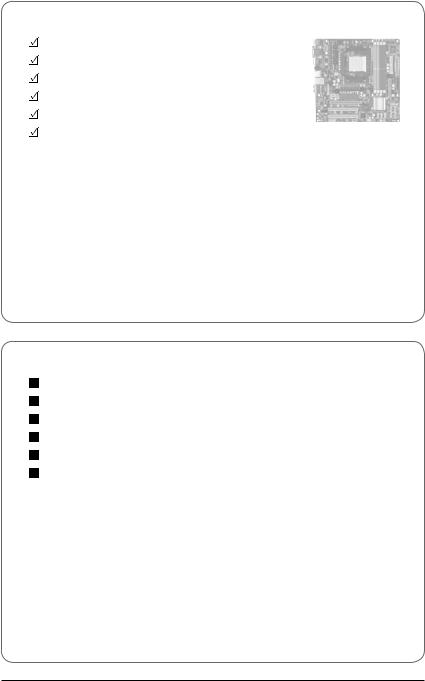
Box Contents
GA-MA78LMT-US2H motherboard
Motherboard driver disk
User's Manual
One IDE cable
Two SATA 3Gb/s cables
I/O Shield
•The box contents above are for reference only and the actual items shall depend on the product package you obtain. The box contents are subject to change without notice.
•The motherboard image is for reference only.
Optional Items
Floppy disk drive cable (Part No. 12CF1-1FD001-7*R)
2-port USB 2.0 bracket (Part No. 12CR1-1UB030-5*R)
2-port SATA power cable (Part No. 12CF1-2SERPW-0*R)
S/PDIF In and Out cable (Part No. 12CR1-1SPINO-1*R)
COM port cable (Part No. 12CF1-1CM001-3*R)
LPT port cable (Part No. 12CF1-1LP001-0*R)
- 6 -
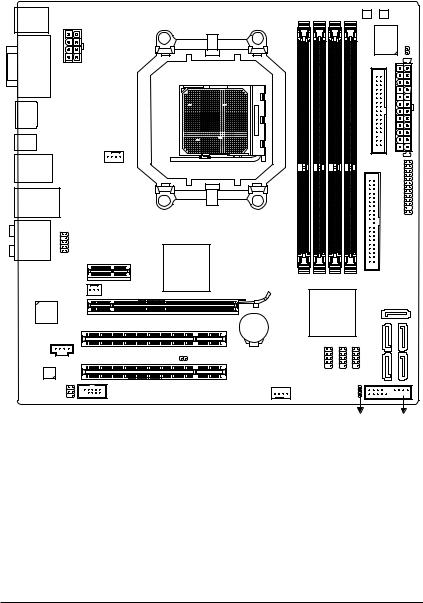
GA-MA78LMT-US2H Motherboard Layout
KB(Note)_USB |
|
|
|
|
|
DVI |
VGA |
ATX_12V_2X4 |
Socket AM3 |
||
|
|
|
|||
|
|
|
|
|
|
HDMI |
|
|
|
|
|
|
OPTICAL |
|
CPU_FAN |
|
|
|
|
|
|
|
|
ESATA |
USB |
|
|
|
|
USB |
LAN |
|
|
|
|
|
|
|
|
|
GA-MA78LMT-US2H |
AUDIO |
|
|
|
|
|
|
|
F_AUDIO |
PCIEX1 |
AMD 760G |
|
|
|
|
|
|
|
|
|
NB_FAN |
PCIEX16 |
||
|
|
|
|
||
|
Realtek |
|
|
|
|
|
RTL8111D/E |
PCI1 |
BAT |
||
|
CD_IN |
||||
|
|
|
|
||
|
CODEC |
PCI2 |
CLR_CMOS |
||
|
|
|
|
||
|
SPDIF_IO |
|
COM |
SYS_FAN |
|
DDR3_1 DDR3_2 DDR3_3 DDR3_4
AMD SB710
F_USB2
F_USB1
M BIOS IT8718 |
B_BIOS |
|
CI |
||
|
|
ATX |
FDD |
|
|
LPT |
IDE |
|
|
SATA2_4 |
F USB3 SATA2 1 SATA2 3 |
SATA2 0 SATA2 2 |
PWR_LED F_PANEL
(Note) Use this port to connect a PS/2 keyboard or PS/2 mouse.
- 7 -

Block Diagram
PCIe CLK
(100 MHz)
1 PCI Express x16
|
|
|
|
|
|
|
|
|
|
|
|
|
PCI Express x16 |
|
||||||||||||
|
|
|
|
|
|
PCI Express Bus |
|
|
|
|
|
|
|
|
|
|
||||||||||
|
|
|
|
|
|
|
|
|
|
|
|
|
|
|
|
|||||||||||
|
|
|
|
|
|
|
|
|
|
|
|
|
|
|
|
|||||||||||
|
|
|
|
|
|
|
|
|
|
|
|
|
|
|
|
|
|
|
|
|
|
|
|
|
|
|
|
|
|
|
|
|
|
|
|
|
|
|
x1 |
|
|
|
|
|
|
|
|
|
|
||||
|
|
|
|
|
|
|
|
|
|
|
|
|
|
|
|
|
|
|
|
|
||||||
|
PCIe CLK |
|
|
|
|
|
|
|
|
|
|
|
|
Realtek |
||||||||||||
|
|
|
|
|
|
|
|
|
|
|
|
RTL8111D/E |
||||||||||||||
|
|
|
|
|
|
|
|
|
|
|
|
|||||||||||||||
|
(100 MHz) |
|
|
|
|
|
|
|
|
|
|
|
|
|
|
|
|
|
|
|
|
|||||
|
|
|
|
|
|
|
|
|
|
|
|
RJ45 |
|
|
||||||||||||
|
|
|
|
|
|
|
|
|
|
|
|
|
|
|
|
|
|
|
||||||||
|
|
|
|
|
|
|
|
|
|
|
|
|
|
|
|
|
|
|
|
|
|
|
|
|
|
|
|
|
|
1 PCI Express x1 |
|
|
|
LAN |
|
|
|
||||||||||||||||
|
|
|
|
|
|
|
|
|
|
|
|
|
||||||||||||||
|
|
|
|
|
|
|
|
|
|
|
|
|
|
|
|
|
|
|
|
|
|
|
|
|
||
|
|
|
|
|
|
|
|
|
|
|
|
|
|
|
|
Dual BIOS |
|
|
|
|
|
|||||
|
|
|
|
|
|
|
|
|
|
|
|
|
|
|
|
|
|
|||||||||
|
|
|
|
|
|
|
|
|
|
|
|
|
|
|
|
|
|
|
|
|
|
|
|
|
|
|
|
|
|
|
|
|
|
|
|
|
|
|
|
|
|
|
|
|
|
|
|
|
|
|
|
|
|
|
|
|
|
|
|
|
|
|
|
|
|
|
PCI Bus |
|
|
|
|
|
|
|
|
|
|
|||
CPU CLK+/- (200 MHz)
AM3 CPU
DDR3 1666 (O.C.)/1333/1066 MHz
Dual Channel Memory
Hyper Transport 3.0
GFX CLK (100 MHz)
D-Sub
AMD 760G
DVI-D or HDMI (Note)
|
|
|
|
|
|
|
|
|
|
|
|
|
|
|
|
|
|
|
|
|
|
|
|
12 USB Ports |
|||
|
AMD SB710 |
|
|
|
|
|
|
|
|
|
|
|
|
|
|
ATA-133/100/66/33 IDE Channel |
|||||||||||
|
|
|
|
|
|
|
|
|
|
|
|
|
|
||||||||||||||
|
|
|
|
|
|
|
|
|
|
|
|
|
|
||||||||||||||
|
|
|
|
|
|
|
|
|
|
|
|
|
|
|
|
|
|
6 SATA 3Gb/s |
|||||||||
|
|
|
|
|
|
|
|
|
|
|
|
|
|
|
|
|
|
||||||||||
|
|
|
|
|
|
|
|
|
|
|
|
|
|
|
|
|
|
|
|
|
|
|
|
||||
|
|
|
|
|
|
|
|
|
|
|
|
|
|
|
|
|
|
|
|
|
|
|
|||||
|
|
|
|
|
|
|
|
|
|
|
|
|
|
|
|
|
|
|
|
|
|
|
|
|
|
|
|
|
|
|
|
|
|
|
|
|
|
|
|
|
|
|
|
|
|
|
|
|
|
|
|
|
|
|
|
|
|
|
|
|
|
|
|
LPC |
|
|
|
|
|
|
|
|
|
|
|
|
|
|
|||||
|
|
|
|
|
|
|
|
|
|
|
|
|
|
|
|
|
|
|
|
|
|||||||
|
|
|
|
|
|
|
|
|
|
|
|
|
|
|
|
|
|
|
Floppy |
|
|||||||
|
|
|
|
|
|
|
|
Bus |
|
|
|
|
|
|
|
|
|
|
|
|
|
||||||
|
|
|
|
|
|
|
|
|
|
|
|
|
|
IT8718 |
|
|
LPT Port |
|
|||||||||
|
|
|
|
|
|
|
|
|
|
|
|
|
|
|
|
|
|||||||||||
|
|
|
|
|
|
|
|
|
|
|
|
|
|
|
|
|
|
||||||||||
|
CODEC |
|
|
|
|
|
|
|
|
|
|
|
|
|
|
|
|
|
|
|
|
|
COM Port |
|
|||
|
|
|
|
|
|
|
|
|
|
|
|
|
|
|
|
|
|
|
|
|
|
|
|
|
|
|
|
|
|
|
|
|
|
|
|
|
|
|
|
|
|
|
|
|
|
|
|
|
|
|
|
|
|
|
|
|
|
|
|
|
|
|
|
|
|
|
|
|
|
|
|
|
|
|
|
|
|
|
|
|
PS/2 |
KB or Mouse |
|
|
|
|
|
|
|
|
|
|
|
|
|
|
|
|
|
|
|
|
|
|
|
|
|
|
|||
2 PCI
PCI CLK
(33 MHz)
Out |
In |
S/PDIF In S/ PDIF Out |
Out |
||
Out |
Line |
|
Speaker Speaker SpeakerOut |
MIC Line |
|
Center/Subwoofer Side |
|
|
Surround |
|
|
(Note) Simultaneous output for DVI-D and HDMI is not supported.
- 8 -

Chapter 1 Hardware Installation
1-1 Installation Precautions
The motherboard contains numerous delicate electronic circuits and components which can become damaged as a result of electrostatic discharge (ESD). Prior to installation, carefully read the user's manual and follow these procedures:
•Prior to installation, do not remove or break motherboard S/N (Serial Number) sticker or warranty sticker provided by your dealer. These stickers are required for warranty validation.
•Always remove the AC power by unplugging the power cord from the power outlet before installing or removing the motherboard or other hardware components.
•When connecting hardware components to the internal connectors on the motherboard, make sure they are connected tightly and securely.
•When handling the motherboard, avoid touching any metal leads or connectors.
•It is best to wear an electrostatic discharge (ESD) wrist strap when handling electronic components such as a motherboard, CPU or memory. If you do not have an ESD wrist strap, keep your hands dry and first touch a metal object to eliminate static electricity.
•Prior to installing the motherboard, please have it on top of an antistatic pad or within an electrostatic shielding container.
•Before unplugging the power supply cable from the motherboard, make sure the power supply has been turned off.
•Before turning on the power, make sure the power supply voltage has been set according to the local voltage standard.
•Before using the product, please verify that all cables and power connectors of your hardware components are connected.
•To prevent damage to the motherboard, do not allow screws to come in contact with the motherboard circuit or its components.
•Make sure there are no leftover screws or metal components placed on the motherboard or within the computer casing.
•Do not place the computer system on an uneven surface.
•Do not place the computer system in a high-temperature environment.
•Turning on the computer power during the installation process can lead to damage to system components as well as physical harm to the user.
•If you are uncertain about any installation steps or have a problem related to the use of the product, please consult a certified computer technician.
- 9 - |
Hardware Installation |
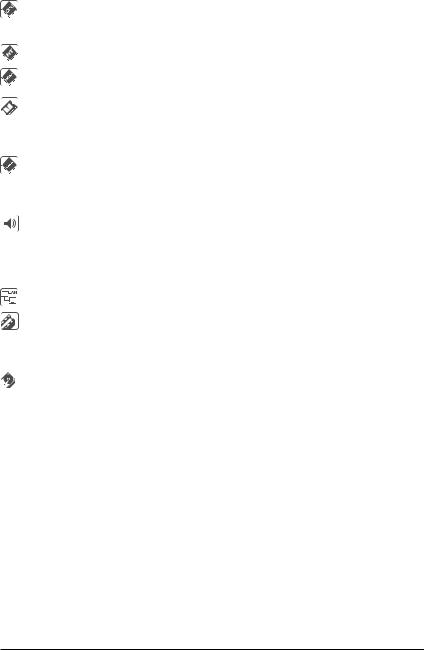
1-2 |
Product Specifications |
||
|
|
|
|
|
CPU |
|
Support for AM3 processors: |
|
|
|
AMD Phenom™ II processor/ AMD Athlon™ II processor |
|
|
|
(Go to GIGABYTE's website for the latest CPU support list.) |
|
Hyper Transport Bus |
5200 MT/s |
|
|
|
|
|
|
Chipset |
|
North Bridge: AMD 760G |
|
|
|
South Bridge: AMD SB710 |
|
Memory |
|
4 x 1.5V DDR3 DIMM sockets supporting up to 16 GB of system memory (Note 1) |
|
|
|
Dual channel memory architecture |
|
|
|
Support for DDR3 1666 (O.C.)/1333/1066 MHz memory modules |
|
|
|
(Go to GIGABYTE's website for the latest memory support list.) |
|
Onboard Graphics |
Integrated in the North Bridge: |
|
|
|
|
- 1 x D-Sub port |
|
|
|
- 1 x DVI-D port (Note 2) (Note 3) |
|
|
|
- 1 x HDMI port (Note 3) |
|
Audio |
|
Realtek ALC888B/892 codec |
|
|
|
High Definition Audio |
|
|
|
2/4/5.1/7.1-channel |
|
|
|
Support for S/PDIF In/Out |
|
|
|
Support for CD In |
|
LAN |
|
Realtek RTL8111D/E chip (10/100/1000 Mbit) |
|
|
|
|
|
Expansion Slots |
|
1 x PCI Express x16 slot, running at x16 |
|
|
|
(The PCI Express x16 slot conforms to PCI Express 2.0 standard.) |
|
|
|
1 x PCI Express x1 slot |
|
|
|
2 x PCI slots |
|
Storage Interface |
|
South Bridge: |
|
|
|
- 1 x IDE connector supporting ATA-133/100/66/33 and up to 2 IDE devices |
|
|
|
- 5 x SATA 3Gb/s connectors (SATA2_0, SATA2_1, SATA2_2, SATA2_3, |
|
|
|
SATA2_4) supporting up to 5 SATA 3Gb/s devices |
|
|
|
- 1 x eSATA 3Gb/s port on the back panel supporting up to 1 SATA 3Gb/s |
|
|
|
device |
|
|
|
- Support for SATA RAID 0, RAID 1, RAID 10, and JBOD |
|
|
|
iTE IT8718 chip: |
|
|
|
- 1 x floppy disk drive connector supporting up to 1 floppy disk drive |
Hardware Installation |
- 10 - |
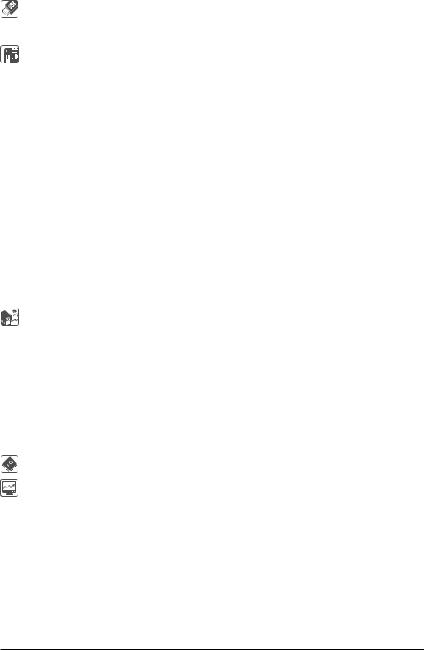
USB |
|
South Bridge |
|
|
|
- |
Up to 12 USB 2.0/1.1 ports (6 on the back panel, 6 via the USB brackets |
|
|
|
connected to the internal USB headers) |
Internal |
w |
1 x 24-pin ATX main power connector |
|
Connectors |
w |
1 x 8-pin ATX 12V power connector |
|
|
w |
1 x floppy disk drive connector |
|
|
w |
1 x IDE connector |
|
|
w |
5 x SATA 3Gb/s connectors |
|
|
w |
1 x CPU fan header |
|
|
w |
1 x system fan header |
|
|
w |
1 x North Bridge fan header |
|
|
w |
1 x front panel header |
|
|
w |
1 x front panel audio header |
|
|
w |
1 x CD In connector |
|
|
w |
1 x S/PDIF In/Out header |
|
|
w |
3 x USB 2.0/1.1 headers |
|
|
w |
1 x serial port header |
|
|
w |
1 x parallel port header |
|
|
w |
1 x power LED header |
|
|
w |
1 x chassis intrusion header |
|
|
w |
1 x clearing CMOS jumper |
|
Back Panel |
w |
1 x PS/2 keyboard port or PS/2 mouse port |
|
Connectors |
w |
1 x D-Sub port |
|
|
w |
1 x DVI-D port (Note 2) (Note 3) |
|
|
w |
1 x HDMI port (Note 3) |
|
|
w |
1 x optical S/PDIF Out connector |
|
|
w |
1 x eSATA 3Gb/s port |
|
|
w |
6 x USB 2.0/1.1 ports |
|
|
w |
1 x RJ-45 port |
|
|
w |
6 x audio jacks (Center/Subwoofer Speaker Out/Rear Speaker Out/ |
|
|
|
Side Speaker Out/Line In/Line Out/Microphone) |
|
I/O Controller |
w |
iTE IT8718 chip |
|
|
|
||
Hardware Monitor w |
System voltage detection |
||
|
w |
CPU/System temperature detection |
|
|
w |
CPU/System fan speed detection |
|
|
w |
CPU overheating warning |
|
|
w |
CPU/System/Power fan fail warning |
|
|
w |
CPU/System fan speed control (Note 4) |
|
- 11 - |
Hardware Installation |
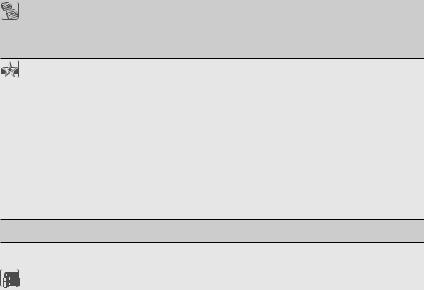
BIOS |
w |
2 x 8 Mbit flash |
|
w |
Use of licensed AWARD BIOS |
wSupport for DualBIOS™
wPnP 1.0a, DMI 2.0, SM BIOS 2.4, ACPI 1.0b
Unique Features w Support for @BIOS w Support for Q-Flash
w Support for Xpress BIOS Rescue w Support for Download Center
w Support for Xpress Install
w Support for Xpress Recovery2 w Support for EasyTune (Note 5)
w Support for Easy Energy Saver w Support for SMART Recovery w Support for ON/OFF Charge w Support for Q-Share
 Bundled Software w Norton Internet Security (OEM version)
Bundled Software w Norton Internet Security (OEM version)
 Operating System w Support for Microsoft® Windows® 7/Vista/XP
Operating System w Support for Microsoft® Windows® 7/Vista/XP
Form Factor |
w Micro ATX Form Factor; 24.4cm x 24.4cm |
|
|
(Note 1) |
Due to Windows 32-bit operating system limitation, when more than 4 GB of physical |
m e m o r y |
|
|
is installed, the actual memory size displayed will be less than 4 GB. |
|
|
(Note 2) The DVI-D port does not support D-Sub connection by adapter. |
|
||
(Note 3) |
Simultaneous output for DVI-D and HDMI is not supported. |
|
|
(Note 4) |
Whether the CPU/system fan speed control function is supported will depend on the CPU/system |
||
|
cooler you install. |
|
|
(Note 5) |
Available functions in EasyTune may differ by motherboard model. |
|
|
|
|
|
|
Hardware Installation |
- 12 - |
|
|
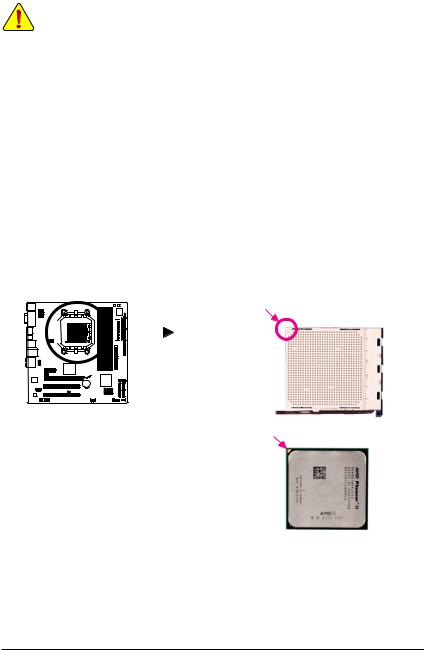
1-3 Installing the CPU and CPU Cooler
Read the following guidelines before you begin to install the CPU:
•Make sure that the motherboard supports the CPU.
(Go to GIGABYTE's website for the latest CPU support list.)
•Always turn off the computer and unplug the power cord from the power outlet before installing the CPU to prevent hardware damage.
•Locate the pin one of the CPU. The CPU cannot be inserted if oriented incorrectly. (Or you may locate the notches on both sides of the CPU and alignment keys on the CPU socket.)
•Apply an even and thin layer of thermal grease on the surface of the CPU.
•Do not turn on the computer if the CPU cooler is not installed, otherwise overheating and damage of the CPU may occur.
•Set the CPU host frequency in accordance with the CPU specifications. It is not recommended that the system bus frequency be set beyond hardware specifications since it does not meet the standard requirements for the peripherals. If you wish to set the frequency beyond the standard specifications, please do so according to your hardware specifications including the CPU, graphics card, memory, hard drive, etc.
1-3-1 Installing the CPU
A. Locate the pin one (denoted by a small triangle) of the CPU socket and the CPU.
|
|
|
|
|
|
|
|
|
|
|
|
|
A Small Triangle Mark |
AM3 Socket |
|
|
|
|
|
|
|
|
|
|
|
|
|
Denotes Pin One of the |
|
|
|
|
|
|
|
|
||||||||
|
|
|
|
|
|
|
|
|
|
|
|
|
||
|
|
|
|
|
|
|
|
|
|
|
|
|
Socket |
|
|
|
|
|
|
|
|
|
|
|
|
|
|
|
|
|
|
|
|
|
|
|
|
|
|
|
|
|
|
|
|
|
|
|
|
|
|
|
|
|
|
|
|
|
|
|
|
|
|
|
|
|
|
|
|
|
|
|
|
|
|
|
|
|
|
|
|
|
|
|
|
|
|
|
|
|
|
|
|
|
|
|
|
|
|
|
|
|
|
|
|
|
|
|
|
|
|
|
|
|
|
|
|
|
|
|
|
|
|
|
|
|
|
|
|
|
|
|
|
|
A Small Triangle Marking |
AM3 CPU |
Denotes CPU Pin One |
- 13 - |
Hardware Installation |
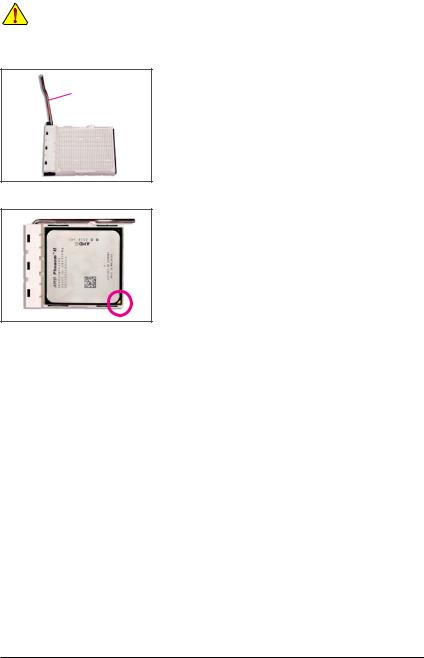
B.Follow the steps below to correctly install the CPU into the motherboard CPU socket.
•Before installing the CPU, make sure to turn off the computer and unplug the power cord from the power outlet to prevent damage to the CPU.
•Do not force the CPU into the CPU socket. The CPU cannot fit in if oriented incorrectly. Adjust the
CPU orientation if this occurs.
CPU Socket
Locking Lever
Step 1:
Completely lift up the CPU socket locking lever.
Step 2:
Align the CPU pin one (small triangle marking) with the triangle mark on the CPU socket and gently insert the CPU into the socket. Make sure that the CPU pins fit perfectly into their holes. Once the CPU is positioned into its socket, place one finger down on the middle of the
CPU, lowering the locking lever and latching it into the fully locked position.
Hardware Installation |
- 14 - |

1-3-2 Installing the CPU Cooler
Follow the steps below to correctly install the CPU cooler on the CPU. (The following procedure uses the GIGABYTE cooler as the example.)
Step 1:
Apply an even and thin layer of thermal grease on the surface of the installed CPU.
Step 3:
Hook the CPU cooler clip to the mounting lug on one side of the retention frame. On the other side,push straight down on the the CPU cooler clip to hook it to the mounting lug on the retention frame.
Step 2:
Place the CPU cooler on the CPU.
Step 4:
Turn the cam handle from the left side to the right side (as the picture above shows) to lock into place. (Refer to your CPU cooler installation manual for instructions on installing the cooler.)
Step 5:
Finally, attach the power connector of the CPU cooler to the CPU fan header (CPU_FAN) on the motherboard.
Use extreme care when removing the CPU cooler because the thermal grease/tape between the CPU cooler and CPU may adhere to the CPU. Inadequately removing the CPU cooler may damage the CPU.
- 15 - |
Hardware Installation |
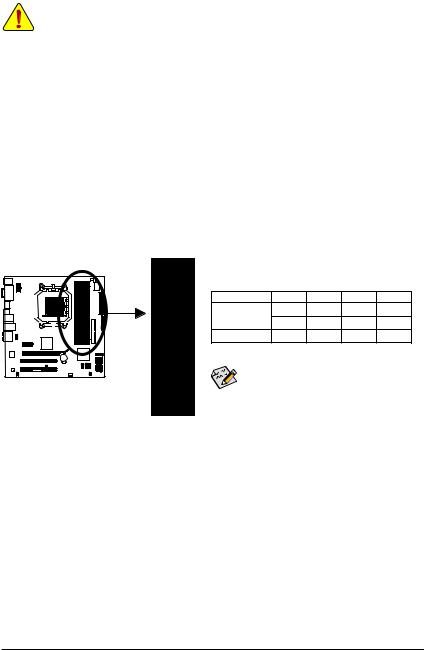
1-4 Installing the Memory
Read the following guidelines before you begin to install the memory:
•Make sure that the motherboard supports the memory. It is recommended that memory of the same capacity, brand, speed, and chips be used.
(Go to GIGABYTE's website for the latest memory support list.)
•Always turn off the computer and unplug the power cord from the power outlet before installing the memory to prevent hardware damage.
•Memory modules have a foolproof design. A memory module can be installed in only one direction. If you are unable to insert the memory, switch the direction.
1-4-1 Dual Channel Memory Configuration
This motherboard provides four DDR3 memory sockets and supports Dual Channel Technology. After the memory is installed, the BIOS will automatically detect the specifications and capacity of the memory. Enabling Dual Channel memory mode will double the original memory bandwidth.
The four DDR3 memory sockets are divided into two channels and each channel has two memory sockets as following:
 Channel 0: DDR3_1, DDR3_3
Channel 0: DDR3_1, DDR3_3
 Channel 1: DDR3_2, DDR3_4
Channel 1: DDR3_2, DDR3_4
 Dual Channel Memory Configurations Table
Dual Channel Memory Configurations Table
|
DDR3_1 DDR3_2 DDR3_3 |
DDR3_4 |
||
Two Modules |
DS/SS |
DS/SS |
- - |
- - |
|
- - |
- - |
DS/SS |
DS/SS |
Four Modules |
DS/SS |
DS/SS |
DS/SS |
DS/SS |
(SS=Single-Sided, DS=Double-Sided, "- -"=No Memory)
If two memory modules are to be installed, it is recommended that you install them in the DDR3_1 and DDR3_2 sockets.
DDR3_4
DDR3_3
DDR3_2
DDR3_1
Due to CPU limitations, read the following guidelines before installing the memory in Dual Channel mode.
1.Dual Channel mode cannot be enabled if only one DDR3 memory module is installed.
2.When enabling Dual Channel mode with two or four memory modules, it is recommended that memory of the same capacity, brand, speed, and chips be used and installed in the same colored DDR3 sockets for optimum performance.
Hardware Installation |
- 16 - |
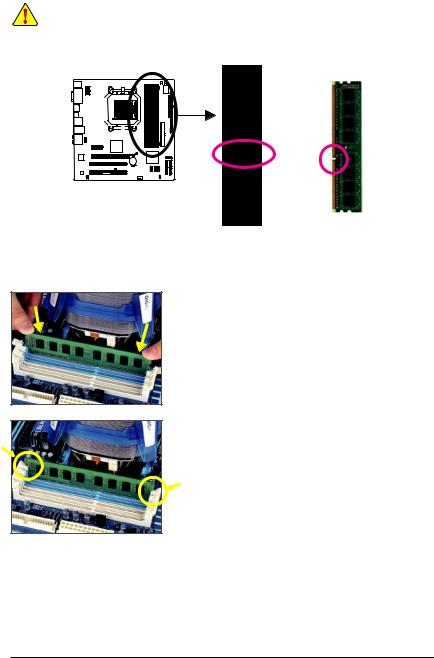
1-4-2 Installing a Memory
Before installing a memory module, make sure to turn off the computer and unplug the power cord from the power outlet to prevent damage to the memory module.
DDR3 and DDR2 DIMMs are not compatible to each other or DDR DIMMs. Be sure to install DDR3 DIMMs on this motherboard.
Notch
DDR3 DIMM
A DDR3 memory module has a notch, so it can only fit in one direction. Follow the steps below to correctly install your memory modules in the memory sockets.
Step 1:
Note the orientation of the memory module. Spread the retaining clips at both ends of the memory socket. Place the memory module on the socket. As indicated in the picture on the left, place your fingers on the top edge of the memory, push down on the memory and insert it vertically into the memory socket.
Step 2:
The clips at both ends of the socket will snap into place when the memory module is securely inserted.
- 17 - |
Hardware Installation |
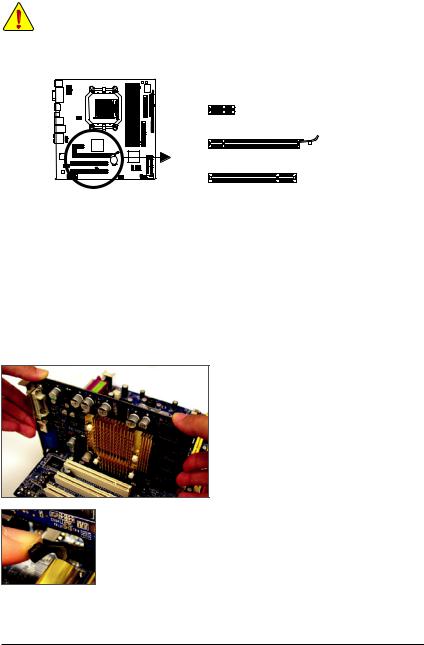
1-5 Installing an Expansion Card
Read the following guidelines before you begin to install an expansion card:
•Make sure the motherboard supports the expansion card. Carefully read the manual that came with your expansion card.
•Always turn off the computer and unplug the power cord from the power outlet before installing an expansion card to prevent hardware damage.
PCI Express x1 Slot
PCI Express x16 Slot
PCI Slot
Follow the steps below to correctly install your expansion card in the expansion slot.
1.Locate an expansion slot that supports your card. Remove the metal slot cover from the chassis back panel.
2.Align the card with the slot, and press down on the card until it is fully seated in the slot.
3.Make sure the metal contacts on the card are completely inserted into the slot.
4.Secure the card’s metal bracket to the chassis back panel with a screw.
5.After installing all expansion cards, replace the chassis cover(s).
6.Turn on your computer. If necessary, go to BIOS Setup to make any required BIOS changes for your expansion card(s).
7.Install the driver provided with the expansion card in your operating system.
Example: Installing and Removing a PCI Express Graphics Card:
• Installing a Graphics Card:
Gently push down on the top edge of the card until it is fully inserted into the PCI Express slot. Make sure the card is securely seated in the slot and does not rock.
•Removing the Card from the PCIEX16_1 slot:
Gently push back on the lever on the slot and then lift the card straight out from the slot.
Hardware Installation |
- 18 - |
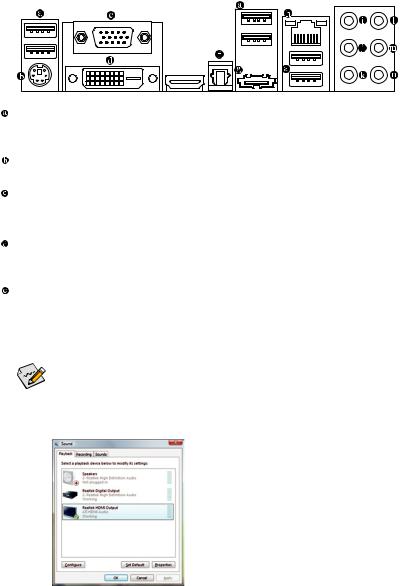
1-6 Back Panel Connectors
(Note 1) (Note 2)
 (Note 2)
(Note 2)
USB 2.0/1.1 Port
The USB port supports the USB 2.0/1.1 specification. Use this port for USB devices such as a USB keyboard/mouse, USB printer, USB flash drive and etc.
PS/2 Keyboard or PS/2 Mouse Port
Use this port to connect a PS/2 keyboard or PS/2 mouse.
D-Sub Port
The D-Sub port supports a 15-pin D-Sub connector. Connect a monitor that supports D-Sub connection to this port.
DVI-D Port (Note 1)(Note 2)
The DVI-D port supports DVI-D specifictation. Connect a monitor that supports DVI-D connection to this port.
HDMI Port (Note 2)
The HDMI (High-Definition Multimedia Interface) provides an all-digital audio/video interface to transmit the uncompressed audio/video signals and is HDCP compliant. Connect the HDMI audio/video device to this port. The HDMI Technology can support a maximum resolution of 1920x1080p but the actual resolutions supported depend on the monitor being used.

 • After installing the HDMI device, make sure the default device for sound playback is the HDMI
• After installing the HDMI device, make sure the default device for sound playback is the HDMI  device. (The item name may differ by operating system. The following screen is from Windows Vista.)
device. (The item name may differ by operating system. The following screen is from Windows Vista.)
•Please note the HDMI audio output only supports AC3, DTS and 2-channel-LPCM formats. (AC3 and DTS require the use of an external decoder for decoding.)
In Windows Vista, select Start>Control Panel>Sound, select Realtek
HDMI Output and then click Set Default.
(Note 1) |
The DVI-D port does not support D-Sub connection by adapter. |
|
(Note 2) |
Simultaneous output for DVI-D and HDMI is not supported. |
|
|
|
|
|
- 19 - |
Hardware Installation |
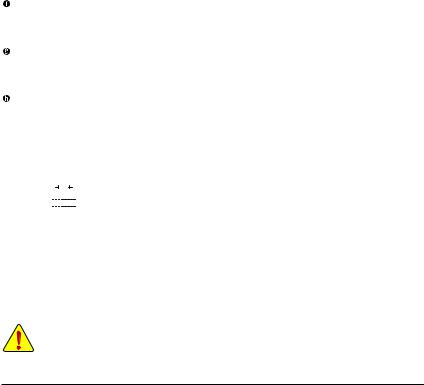
A. Dual Display Configurations:
This motherboard provides three ports for video output: DVI-D, HDMI and D-Sub. The table below shows the supported dual display configurations.
Dual |
Combination |
Supported or Not |
Display |
DVI-D + D-Sub |
Yes |
|
DVI-D + HDMI |
No |
|
HDMI + D-Sub |
Yes |
B. Playback of HD DVD and Blu-ray Discs:
In order to get better playback quality, when playing the HD DVD or Blu-ray discs, refer to the recommended system requirements (or better) below.
•Memory: Two 1 GB DDR3 1066 memory modules with dual channel mode enabled
•BIOS Setup: At least 256 MB of UMA Frame Buffer Size (refer to Chapter 2, "BIOS Setup," "Advanced BIOS Features," for more information)
•Playback software: CyberLink PowerDVD 8.0 or later (Note: Please ensure Hardware Acceleration is enabled.)
•HDCP compliant monitor(s)
Optical S/PDIF Out Connector
This connector provides digital audio out to an external audio system that supports digital optical audio. Before using this feature, ensure that your audio system provides an optical digital audio in connector. eSATA 3Gb/s Port
The eSATA 3Gb/s port conforms to SATA 3Gb/s standard and is compatible with SATA 1.5Gb/s standard. Use the port to connect an external SATA device or a SATA port multiplier.
RJ-45 LAN Port
The Gigabit Ethernet LAN port provides Internet connection at up to 1 Gbps data rate. The following describes the states of the LAN port LEDs.
Connection/ |
|
|
|
|
Activity LED |
Connection/Speed LED: |
Activity LED: |
||||||||||||
Speed LED |
|
|
|
|
|||||||||||||||
|
|
|
|
|
|
|
|
|
|
|
|
|
|
|
State |
Description |
|
State |
Description |
|
|
|
|
|
|
|
|
|
|
|
|
|
|
|
Orange |
1 Gbps data rate |
|
Blinking |
Data transmission or receiving is occurring |
|
|
|
|
|
|
|
|
|
|
|
|
|
|
|
Green |
100 Mbps data rate |
|
Off |
No data transmission or receiving is occurring |
|
|
|
|
LAN Port |
Off |
10 Mbps data rate |
|
|
|
||||||||||
|
|
|
|
|
|
|
|
|
|||||||||||
•When removing the cable connected to a back panel connector, first remove the cable from your device and then remove it from the motherboard.
•When removing the cable, pull it straight out from the connector. Do not rock it side to side to prevent an electrical short inside the cable connector.
Hardware Installation |
- 20 - |

Center/Subwoofer Speaker Out Jack (Orange)
Use this audio jack to connect center/subwoofer speakers in a 5.1/7.1-channel audio configuration.
Rear Speaker Out Jack (Black)
Use this audio jack to connect rear speakers in a 4/5.1/7.1-channel audio configuration.
Side Speaker Out Jack (Gray)
Use this audio jack to connect side speakers in a 7.1-channel audio configuration.
Line In Jack (Blue)
The default line in jack. Use this audio jack for line in devices such as an optical drive, walkman, etc.
Line Out Jack (Green)
The default line out jack. Use this audio jack for a headphone or 2-channel speaker. This jack can be used to connect front speakers in a 4/5.1/7.1-channel audio configuration.
Mic In Jack (Pink)
The default Mic in jack. Microphones must be connected to this jack.

 In addition to the default speakers settings, the
In addition to the default speakers settings, the ~
~ audio jacks can be reconfigured to perform
audio jacks can be reconfigured to perform
different functions via the audio software. Only microphones still MUST be connected to the default Mic in jack ( ). Refer to the instructions on setting up a 2/4/5.1/7.1-channel audio con-
). Refer to the instructions on setting up a 2/4/5.1/7.1-channel audio con-
figuration in Chapter 5, "Configuring 2/4/5.1/7.1-Channel Audio."
- 21 - |
Hardware Installation |
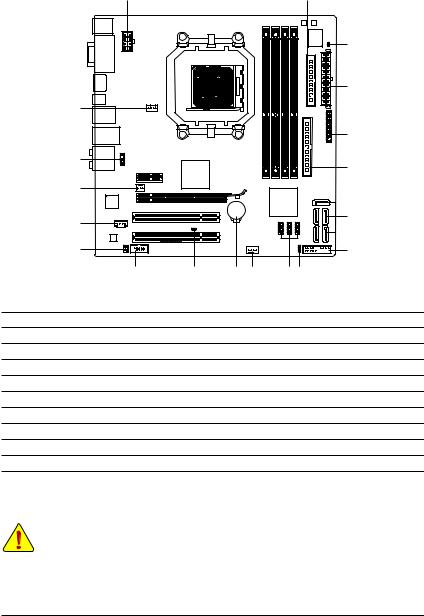
1-7 |
Internal Connectors |
|
|
|
|
|
1 |
|
|
|
6 |
|
|
|
|
|
17 |
|
|
|
|
|
2 |
|
3 |
|
|
|
|
|
|
|
|
|
15 |
|
11 |
|
|
|
7 |
|
|
|
|
|
|
|
5 |
|
|
|
|
|
12 |
|
|
|
8 |
|
|
|
|
|
|
|
13 |
|
|
|
10 |
|
16 |
18 |
19 |
4 |
14 9 |
1) |
ATX_12V_2X4 |
|
11) |
F_AUDIO |
|
2) |
ATX |
|
12) |
CD_IN |
|
3) |
CPU_FAN |
|
13) |
SPDIF_IO |
|
4) |
SYS_FAN |
|
14) |
F_USB1/F_USB2/F_USB3 |
|
5) |
NB_FAN |
|
15) |
LPT |
|
6) |
FDD |
|
16) |
COM |
|
7) |
IDE |
|
17) |
CI |
|
8) |
SATA2_0/1/2/3/4 |
|
18) |
CLR_CMOS |
|
9) |
PWR_LED |
|
19) |
BAT |
|
10) |
F_PANEL |
|
|
|
|
Read the following guidelines before connecting external devices:
•First make sure your devices are compliant with the connectors you wish to connect.
•Before installing the devices, be sure to turn off the devices and your computer. Unplug the power cord from the power outlet to prevent damage to the devices.
•After installing the device and before turning on the computer, make sure the device cable has been securely attached to the connector on the motherboard.
Hardware Installation |
- 22 - |
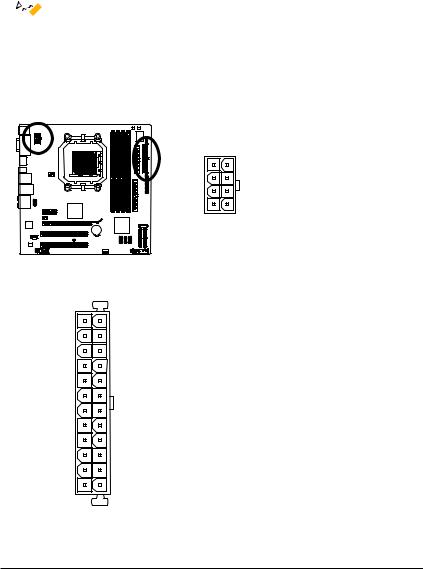
1/2) ATX_12V_2X4/ATX (2x4 12V Power Connector and 2x12 Main Power Connector)
With the use of the power connector, the power supply can supply enough stable power to all the components on the motherboard. Before connecting the power connector, first make sure the power supply is turned off and all devices are properly installed. The power connector possesses a foolproof design. Connect the power supply cable to the power connector in the correct orientation. The 12V power connector mainly supplies power to the CPU. If the 12V power connector is not connected, the computer will not start.
 •
•
•The power connectors are compatible with power supplies with 2x2 12V and 2x10 power connectors. When using a power supply providing a 2x4 12V and a 2x12 power connector, remove the protective covers from the 12V power connector and the main power connector on the motherboard. Do not insert the power supply cables into pins under the protective covers when using a power supply providing a 2x2 12V and a 2x10 power connector.
12 24
1 13
ATX
|
|
|
ATX_12V_2X4: |
|
|
|
|
Pin No. |
Definition |
|
1 |
5 |
1 |
GND (Only for 2x4-pin 12V) |
|
2 |
GND (Only for 2x4-pin 12V) |
||
|
|
|
||
|
|
|
3 |
GND |
|
4 |
8 |
4 |
GND |
|
5 |
+12V (Only for 2x4-pin 12V) |
||
|
|
|
||
|
ATX_12V_2X4 |
6 |
+12V (Only for 2x4-pin 12V) |
|
|
|
|
7 |
+12V |
|
|
|
8 |
+12V |
ATX: |
|
|
|
|
Pin No. |
Definition |
|
Pin No. |
Definition |
1 |
3.3V |
|
13 |
3.3V |
2 |
3.3V |
|
14 |
-12V |
3 |
GND |
|
15 |
GND |
4 |
+5V |
|
16 |
PS_ON (soft On/Off) |
5 |
GND |
|
17 |
GND |
6 |
+5V |
|
18 |
GND |
7 |
GND |
|
19 |
GND |
8 |
Power Good |
|
20 |
-5V |
9 |
5VSB (stand by +5V) |
21 |
+5V |
|
10 |
+12V |
|
22 |
+5V |
11 |
+12V (Only for 2x12-pin ATX) |
23 |
+5V (Only for 2x12-pin ATX) |
|
12 |
3.3V (Only for 2x12-pin ATX) |
24 |
GND (Only for 2x12-pin ATX) |
|
- 23 - |
Hardware Installation |
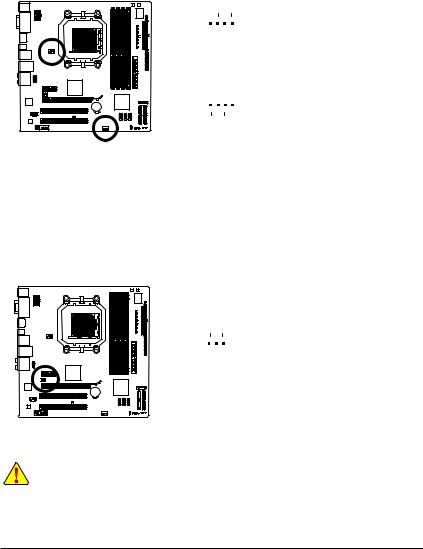
3/4) CPU_FAN/SYS_FAN (Fan Headers)
The motherboard has a 4-pin CPU fan header (CPU_FAN)and a 4-pin system fan header(SYS_FAN). Each fan header supplies a +12V power voltage and possesses a foolproof insertion design. When connecting a fan cable, be sure to connect it in the correct orientation. Most fans are designed with colorcoded power connector wires. A red power connector wire indicates a positive connection and requires a +12V voltage. The black connector wire is the ground wire. The motherboard supports CPU fan speed control, which requires the use of a CPU fan with fan speed control design. For optimum heat dissipation, it is recommended that a system fan be installed inside the chassis.
|
|
|
|
|
|
|
|
|
|
|
|
|
|
|
|
CPU_FAN: |
|
|
|
|
|
|
|
|
|
|
|
|
|
|
|
|
|
|
|
Pin No. |
Definition |
|
|
|
|
|
|
|
|
|
|
|
|
|
|
|
1 |
|
1 |
GND |
|
|
|
|
|
|
|
|
|
|
|
|
|
|
|
|
|||
|
|
|
|
|
|
|
|
|
|
|
|
|
|
|
|
|
2 |
+12V / Speed Control |
|
|
|
|
|
|
|
|
|
|
CPU_FAN |
|
|
||||||
|
|
|
|
|
|
|
|
|
|
|
|
|||||||
|
|
|
|
|
|
|
|
|
|
|
|
|
|
|||||
|
|
|
|
|
|
|
|
|
|
|
3 |
Sense |
||||||
|
|
|
|
|
|
|
|
|
|
|
|
|
|
|
|
|
||
|
|
|
|
|
|
|
|
|
|
|
|
|
|
|
|
|
||
|
|
|
|
|
|
|
|
|
|
|
|
|
|
|
|
|
4 |
Speed Control |
|
|
|
|
|
|
|
|
|
|
|
|
|
|
|
|
|||
|
|
|
|
|
|
|
|
|
|
|
|
|
|
|
|
SYS_FAN: |
|
|
|
|
1 |
|
|
|
|
|
|
|
Pin No. |
Definition |
|||||||
|
|
|
|
|
|
|
|
|
||||||||||
|
|
|
|
|
|
|
|
|
1 |
GND |
||||||||
|
|
|
|
|
|
|
|
|
|
|
|
|
|
|
|
|
||
|
|
|
|
|
|
|
|
|
|
|
|
|
|
|
|
|
|
|
|
|
|
|
|
|
|
|
|
|
|
|
|
|
|
|
|
|
|
|
|
|
|
|
|
|
|
|
|
SYS_FAN |
|
|
2 |
+12V / Speed Control |
||||
|
|
|
|
|
|
|
|
|
|
|
|
|
|
|
|
|
3 |
Sense |
|
|
|
|
|
|
|
|
|
|
|
|
|
|
|
|
|
4 |
Reserve |
5)NB_FAN (North Bridge Fan Header)
Connect the North Bridge fan cable to this header. The fan header has a foolproof insertion design. When connecting a fan cable, be sure to connect it in the correct orientation. Most fans are designed with color-coded power connector wires. A red power connector wire indicates a positive connection and requires a +12V voltage. The black connector wire is the ground wire.
|
|
|
|
|
|
|
|
|
|
|
|
|
|
|
|
|
|
|
|
|
|
|
|
|
|
|
|
|
|
|
|
|
|
|
|
|
|
|
|
|
|
|
|
|
|
|
|
|
|
|
|
|
|
|
|
|
|
|
|
|
|
|
|
|
|
|
|
|
|
|
|
|
|
|
|
|
|
|
|
|
|
|
|
|
|
|
|
Pin No. |
Definition |
|
|
|
|
|
|
|
|
|
|
|
|
|
|
|
|
||
|
|
|
|
|
|
|
|
|
|
|
|
|
|
|
|
|
|
|
|
|
|
|
|
|
|
|
|
|
|
|
|
|
1 |
1 |
GND |
|
|
|
|
|
|
|
|
|
|
|
2 |
+12V |
|||||
|
|
|
|
||||||||||||||
|
|
|
|
||||||||||||||
|
|
|
|
|
|
|
|
|
|
|
|
|
|
|
|
3 |
NC |
|
|
|
|
|
|
|
|
|
|
|
|
|
|
|
|
|
|
•Be sure to connect fan cables to the fan headers to prevent your CPU, North Bridge and system from overheating. Overheating may result in damage to the CPU/North Bridge or the system may hang.
•These fan headers are not configuration jumper blocks. Do not place a jumper cap on the headers.
Hardware Installation |
- 24 - |
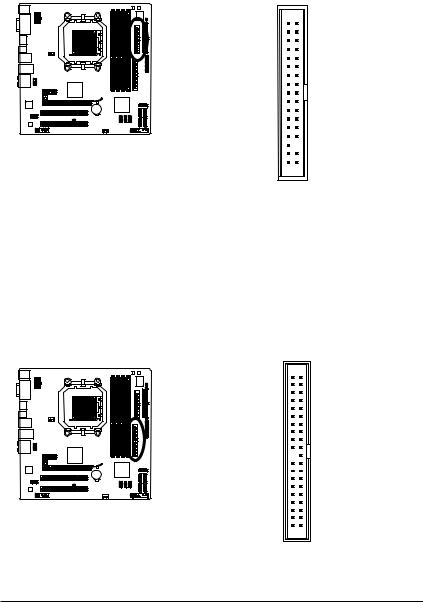
6)FDD (Floppy Disk Drive Connector)
This connector is used to connect a floppy disk drive. The types of floppy disk drives supported are: 360 KB, 720 KB, 1.2 MB, 1.44 MB, and 2.88 MB. Before connecting a floppy disk drive, be sure to locate pin 1 of the connector and the floppy disk drive cable. The pin 1 of the cable is typically designated by a stripe of different color. For purchasing the optional floppy disk drive cable, please contact the local dealer.
34 33
2 1
7)IDE (IDE Connector)
The IDE connector supports up to two IDE devices such as hard drives and optical drives. Before attaching the IDE cable, locate the foolproof groove on the connector. If you wish to connect two IDE devices, remember to set the jumpers and the cabling according to the role of the IDE devices (for example, master or slave). (For information about configuring master/slave settings for the IDE devices, read the instructions from the device manufacturers.)
40 39
2 1
- 25 - |
Hardware Installation |
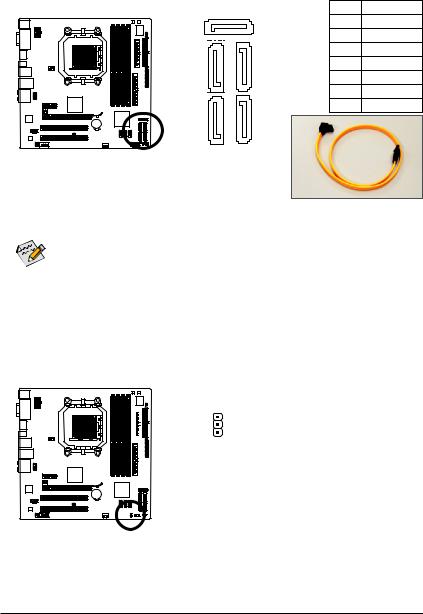
8)SATA2_0/1/2/3/4 (SATA 3Gb/s Connectors)
The SATA connectors conform to SATA 3Gb/s standard and are compatible with SATA 1.5Gb/s standard. Each SATA connector supports a single SATA device. The AMD SB710 controller supports RAID 0, RAID 1,
RAID 10, and JBOD. Refer to Chapter 5, "Configuring SATA Hard Drive(s)," for instructions on configur-
ing a RAID array.
SATA2_4 |
|
7 |
1 |
1 |
7 |
SATA2_3 |
SATA2_2 |
SATA2_1 |
SATA2_0 |
7 |
1 |
Pin No. |
Definition |
1 |
GND |
2 |
TXP |
3 |
TXN |
4 |
GND |
5 |
RXN |
6 |
RXP |
7 |
GND |
Please connect the L-shaped end of the SATA 3Gb/s cable to your SATA hard drive.
•A RAID 0 or RAID 1 configuration requires at least two hard drives. If more than two hard drives are to be used, the total number of hard drives must be an even number.
•A RAID 10 configuration requires at least four hard drives and the total number of hard drives must be an even number.
9)PWR_LED (System Power LED Header)
This header can be used to connect a system power LED on the chassis to indicate system power status. The LED is on when the system is operating. The LED keeps blinking when the system is in S1 sleep state. The LED is off when the system is in S3/S4 sleep state or powered off (S5).
|
|
|
|
|
|
|
|
|
|
|
Pin No. |
|
Definition |
|
|
|
|
|
|
|
|
|
|
|
|
|
|
|
|
|
|
|
|
|
|
|
|
|
|
|
1 |
|
MPD+ |
|
|
|
|
|
|
|
|
|
|
|
|
|
|||
|
|
|
|
|
|
|
|
|
|
|
|
|||
|
|
|
|
|
|
|
|
|
|
|
|
|||
|
|
|
|
|
|
|
|
1 |
2 |
|
MPD- |
|||
|
|
|
|
|
|
|
|
|
||||||
|
|
|
|
|
|
|
|
|
||||||
|
|
|
|
|
3 |
|
MPD- |
|||||||
|
|
|
|
|
|
|
|
|
|
|
|
|||
|
|
|
|
|
|
|
|
|
|
|
|
|
||
|
|
|
|
|
|
|
|
|
|
|
|
|
|
|
|
|
|
|
|
|
|
|
|
|
|
System Status |
LED |
||
|
|
|
|
|
|
|
|
|
|
|
S0 |
|
On |
|
|
|
|
|
|
|
|
|
|
|
|
S1 |
|
Blinking |
|
|
|
|
|
|
|
|
|
|
|
|
S3/S4/S5 |
|
Off |
|
|
|
|
|
|
|
|
|
|
|
|
|
|
|
|
Hardware Installation |
- 26 - |
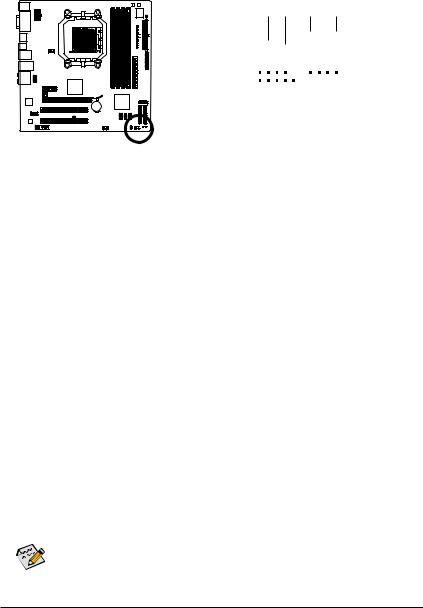
10)F_PANEL (Front Panel Header)
Connect the power switch, reset switch, speaker and system status indicator on the chassis front panel to this header according to the pin assignments below. Note the positive and negative pins before connecting the cables.
|
|
|
|
|
|
|
|
|
|
|
Message/Power/ |
|
Power |
|
|
|
|
|
|
||||||||||
|
|
|
|
|
|
|
|
|
|
|
|
Sleep LED |
|
Switch |
|
|
Speaker |
|
|||||||||||
|
|
|
|
|
|
|
|
|
|
|
|
|
|
|
|
|
|
|
|
|
|
|
|
|
|
|
|
|
|
|
|
|
|
|
|
|
|
|
|
|
|
|
MSG+ MSG |
|
-PW |
SPEAK+ |
|
-SPEAK |
|||||||||||
|
|
|
|
|
|
|
|
|
|
|
|
|
|
|
|||||||||||||||
|
|
|
|
|
|
|
|
|
|
|
|
|
|
- PW+ |
|
|
|
|
|
||||||||||
|
|
|
|
|
|
|
|
|
|
|
|
|
|
|
|
|
|
|
|||||||||||
|
|
|
|
|
|
|
|
|
|
|
|
|
|
|
|
|
|
|
|||||||||||
|
|
|
|
|
|
|
|
|
|
|
|
|
|
|
|
|
|
|
|
|
|
|
|
|
|
|
|
|
|
|
|
|
|
|
|
|
|
|
|
|
|
|
|
|
|
|
|
|
|
|
|
|
|
|
|
|
|
|
|
|
|
|
|
2 |
|
|
|
|
|
|
|
|
|
|
|
|
|
|
|
|
20 |
||||||||
|
|
|
|
|
|
|
|
|
|
|
|
|
|
|
|
|
|
|
|
||||||||||
|
|
1 |
|
|
|
|
|
|
|
|
|
|
|
|
|
|
|
|
19 |
||||||||||
|
|
|
|
|
|
|
|
|
|
|
|
|
|
|
|
|
|
||||||||||||
|
|
|
|
|
|
|
|
|
|
|
|
|
|
|
|
|
|
|
|
|
|
|
|
|
|
|
|
|
|
|
|
|
|
|
|
|
|
|
|
|
|
|
|
HD- |
|
RES+ |
|
|
|
|
|
|
|
||||||
|
|
|
|
|
|
|
|
|
|
|
|
|
|
|
|
|
|
|
|
|
|||||||||
|
|
|
|
|
|
|
|
|
|
|
|
|
HD+ |
RES- |
|
NC |
|
|
|
|
|
||||||||
|
|
|
|
|
|
|
|
|
|
|
|
|
|
|
|
|
|
|
|||||||||||
|
|
|
|
|
|
|
|
|
|
|
|
|
|
|
|
|
|
|
|
|
|
|
|
|
|
|
|
|
|
|
|
|
|
|
|
|
|
|
|
|
|
|
|
|
|
|
|
|
|
|
|
|
|
|
|
|
|
||
|
|
|
|
|
|
|
|
|
|
|
|
|
|
|
|
|
|
|
|
|
|
|
|
|
|
|
|
|
|
|
|
|
|
|
|
|
|
|
|
|
|
Hard Drive |
|
Reset |
|
|
|
|
|
||||||||||
|
|
|
|
|
|
|
|
|
|
|
|
Activity LED |
|
Switch |
|
|
|
|
|
|
|||||||||
• MSG (Message/Power/Sleep LED, Yellow):
System Status |
LED |
S0 |
On |
S1 |
Blinking |
S3/S4/S5 |
Off |
Connects to the power status indicator on the chassis front panel. The LED is on when the system is operating. The LED keeps blinking when the system is in S1 sleep state. The LED is off when the system is in S3/S4 sleep state or powered off (S5).
•PW (Power Switch, Red):
Connects to the power switch on the chassis front panel. You may configure the way to turn off your system using the power switch (refer to Chapter 2, "BIOS Setup," "Power Management Setup," for more information).
•SPEAK (Speaker, Orange):
Connects to the speaker on the chassis front panel. The system reports system startup status by issuing a beep code. One single short beep will be heard if no problem is detected at system startup. If a problem is detected, the BIOS may issue beeps in different patterns to indicate the problem. Refer to Chapter 5, "Troubleshooting," for information about beep codes.
•HD (Hard Drive Activity LED, Blue)
Connects to the hard drive activity LED on the chassis front panel. The LED is on when the hard drive is reading or writing data.
•RES (Reset Switch, Green):
Connects to the reset switch on the chassis front panel. Press the reset switch to restart the computer if the computer freezes and fails to perform a normal restart.
•NC (Purple): No connection
The front panel design may differ by chassis. A front panel module mainly consists of power switch, reset switch, power LED, hard drive activity LED, speaker and etc. When connecting your chassis front panel module to this header, make sure the wire assignments and the pin assignments are matched correctly.
- 27 - |
Hardware Installation |
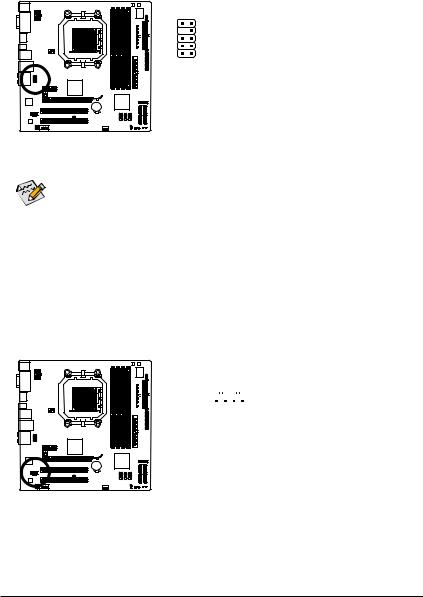
11)F_AUDIO (Front Panel Audio Header)
The front panel audio header supports Intel High Definition audio (HD) and AC'97 audio. You may connect your chassis front panel audio module to this header. Make sure the wire assignments of the module connector match the pin assignments of the motherboard header. Incorrect connection between the module connector and the motherboard header will make the device unable to work or even damage it.
|
|
|
|
|
|
|
|
|
|
|
|
For HD Front Panel Audio: |
|
For AC'97 Front Panel Audio: |
||
|
|
|
|
|
|
|
|
10 |
9 |
Pin No. |
Definition |
|
Pin No. |
Definition |
||
|
|
|
|
|
|
|
|
|
||||||||
|
|
|
|
|
|
|
|
|
||||||||
|
|
|
|
|
|
|
|
|
||||||||
|
|
|
|
1 |
MIC2_L |
|
1 |
MIC |
||||||||
|
|
|
|
|
|
|
|
|
|
|
|
|
||||
|
|
|
|
|
|
|
|
|
|
|
|
|
|
|
|
|
|
|
|
|
|
|
|
|
2 |
1 |
2 |
GND |
|
2 |
GND |
||
|
|
|
|
3 |
MIC2_R |
|
3 |
MIC Power |
||||||||
|
|
|
|
|
|
|
|
|
|
|
|
|
||||
|
|
|
|
|
|
|
|
|
|
|
|
|
|
|
|
|
|
|
|
|
|
|
|
|
|
|
|
|
4 |
-ACZ_DET |
|
4 |
NC |
|
|
|
|
|
|
|
|
|
|
|
|
|
||||
|
|
|
|
|
|
|
|
|
|
|
|
5 |
LINE2_R |
|
5 |
Line Out (R) |
|
|
|
|
|
|
|
|
|
|
|
|
6 |
GND |
|
6 |
NC |
|
|
|
|
|
|
|
|
|
|
|
|
7 |
FAUDIO_JD |
|
7 |
NC |
|
|
|
|
|
|
|
|
|
|
|
|
8 |
No Pin |
|
8 |
No Pin |
|
|
|
|
|
|
|
|
|
|
|
|
|
||||
|
|
|
|
|
|
|
|
|
|
|
|
9 |
LINE2_L |
|
9 |
Line Out (L) |
|
|
|
|
|
|
|
|
|
|
|
|
10 |
GND |
|
10 |
NC |
•The front panel audio header supports HD audio by default. If your chassis provides an AC'97 front panel audio module, refer to the instructions on how to activate AC'97 functionality via the audio software in Chapter 5, "Configuring 2/4/5.1/7.1-Channel Audio."
•Audio signals will be present on both of the front and back panel audio connections simultaneously. If you want to mute the back panel audio (only supported when using an HD front panel audio module), refer to Chapter 5, "Configuring 2/4/5.1/7.1-Channel Audio."
•Some chassis provide a front panel audio module that has separated connectors on each wire instead of a single plug. For information about connecting the front panel audio module that has different wire assignments, please contact the chassis manufacturer.
12)CD_IN (CD In Connector)
You may connect the audio cable that came with your optical drive to the header.
|
|
|
|
|
|
|
|
|
|
|
|
|
|
|
|
|
Pin No. |
Definition |
|
|
|
|
|
|
|
|
|
|
|
|
|
|
|
|
|
||
|
|
|
|
|
|
|
|
|
|
|
|
|
|
|
|
|
||
|
|
|
|
|
|
|
|
|
|
|
|
|
|
|
|
|
||
|
|
|
|
|
|
|
|
1 |
|
|
|
|
|
|
1 |
CD-L |
||
|
|
|
|
|
|
|
|
|
|
|
2 |
GND |
||||||
|
|
|
|
|
|
|
|
|
|
|
|
|
|
|
|
|
||
|
|
|
|
|
|
|
|
|
|
|
|
|
|
|
|
|
3 |
GND |
|
|
|
|
|
|
|
|
|
|
|
|
|
|
|
|
|
||
|
|
|
|
|
|
|
|
|
|
|
|
|
|
|
|
|
4 |
CD-R |
|
|
|
|
|
|
|
|
|
|
|
|
|
|
|
|
|
||
|
|
|
|
|
|
|
|
|
|
|
|
|
|
|
|
|
|
|
Hardware Installation |
- 28 - |
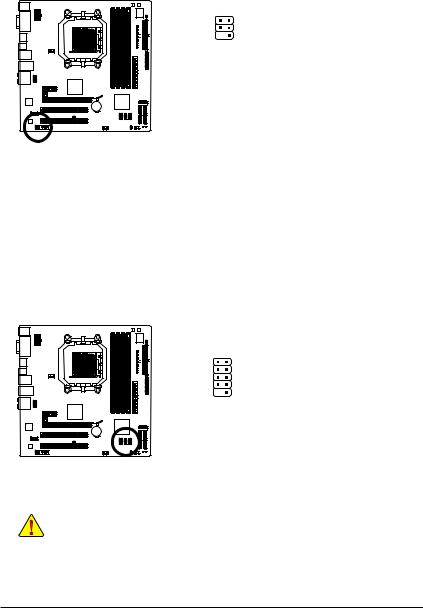
13)SPDIF_IO (S/PDIF In/Out Header)
This header supports digital S/PDIF In/Out. Via an optional S/PDIF In and Out cable, this header can connect to an audio device that supports digital audio out and an audio system that supports digital audio in. For purchasing the optional S/PDIF In and Out cable, please contact the local dealer.
|
|
|
|
|
|
|
|
|
|
|
6 |
5 |
Pin No. |
Definition |
||
|
|
|
|
|
|
|
|
|
|
|
||||||
|
|
|
|
|
|
|
|
|
|
1 |
Power |
|||||
|
|
|
|
|
||||||||||||
|
|
|
||||||||||||||
|
|
|
|
|
|
|
|
|
|
|
2 |
1 |
||||
|
|
|
|
|
2 |
No Pin |
||||||||||
|
|
|
|
|
|
|
|
|
|
|
||||||
|
|
|
|
|
|
|
|
|
|
|
||||||
|
|
|
|
|
|
|
|
|
|
|
|
|
|
|
3 |
SPDIF |
|
|
|
|
|
|
|
|
|
|
|
|
|
|
|
||
|
|
|
|
|
|
|
|
|
|
|
|
|
|
|
4 |
SPDIFI |
|
|
|
|
|
|
|
|
|
|
|
|
|
|
|
||
|
|
|
|
|
|
|
|
|
|
|
|
|
|
|
||
|
|
|
|
|
|
|
|
|
|
|
|
|
|
|
5 |
GND |
|
|
|
|
|
|
|
|
|
|
|
|
|
|
|
6 |
GND |
|
|
|
|
|
|
|
|
|
|
|
|
|
|
|
|
|
14)F_USB1/F_USB2/F_USB3 (USB Headers)
The headers conform to USB 2.0/1.1 specification. Each USB header can provide two USB ports via an optional USB bracket. For purchasing the optional USB bracket, please contact the local dealer.
|
|
|
|
|
|
|
|
|
|
|
|
|
Pin No. |
Definition |
|
|
|
|
|
|
|
|
|
|
|
|
|
1 |
Power (5V) |
|
|
|
|
|
|
|
|
|
|
|
|
|
||
|
|
|
|
|
|
|
|
|
|
|
|
|
||
|
|
|
|
|
|
|
|
|
|
|
|
|
||
|
|
|
|
|
|
|
|
|
1 |
2 |
2 |
Power (5V) |
||
|
|
|
|
|
|
|
|
|
||||||
|
|
|
|
|
|
|||||||||
|
|
3 |
USB DX- |
|||||||||||
|
|
|
|
|
|
|
|
|
|
|
|
|
||
|
|
|
|
|
|
|
|
|
|
|
|
|
||
|
|
|
|
|
|
|
|
|
|
|
|
|
4 |
USB DY- |
|
|
|
9 |
10 |
||||||||||
|
|
|
5 |
USB DX+ |
||||||||||
|
|
|
|
|
|
|
|
|
|
|
|
|
||
|
|
|
|
|
|
|
|
|
|
|
|
|
6 |
USB DY+ |
|
|
|
|
|
|
|
|
|
|
|
|
|
7 |
GND |
|
|
|
|
|
|
|
|
|
|
|
|
|
8 |
GND |
|
|
|
|
|
|
|
|
|
|
|
|
|
9 |
No Pin |
|
|
|
|
|
|
|
|
|
|
|
|
|
||
|
|
|
|
|
|
|
|
|
|
|
|
|
10 |
NC |
•Do not plug the IEEE 1394 bracket (2x5-pin) cable into the USB header.
•Prior to installing the USB bracket, be sure to turn off your computer and unplug the power cord from the power outlet to prevent damage to the USB bracket.
- 29 - |
Hardware Installation |
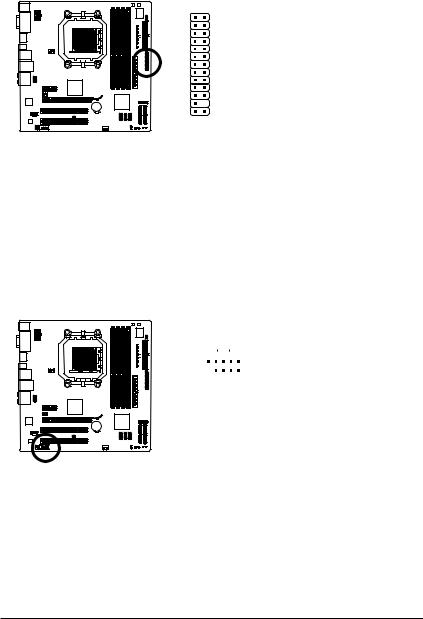
15)LPT (Parallel Port Header)
The LPT header can provide one parallel port via an optional LPT port cable. For purchasing the optional LPT port cable, please contact the local dealer.
|
|
|
|
|
|
|
|
|
|
|
|
|
|
Pin No. |
Definition |
Pin No. |
Definition |
|
|
|
|
|
|
|
|
|
|
1 |
2 |
1 |
STB- |
14 |
GND |
||
|
|
|
|
|
|
|
|
|
|
||||||||
|
|
|
|
|
|
|
|
|
|
||||||||
|
|
|
|
|
|
|
|
|
|
|
|
||||||
|
|
|
2 |
AFD- |
15 |
PD6 |
|||||||||||
|
|
|
|
|
|
|
|
|
|
|
|
|
|
||||
|
|
|
|
|
|
|
|
|
|
|
|
|
|
3 |
PD0 |
16 |
GND |
|
|
|
|
|
|
|
|
|
|
|
|
|
|
||||
|
|
|
|
|
|
|
|
|
|
|
|
|
|
4 |
ERR- |
17 |
PD7 |
|
|
|
|
|
|
|
|
|
|
|
|
|
|
||||
|
|
|
|
|
|
|
|
|
|
|
|
|
|
5 |
PD1 |
18 |
GND |
|
|
|
|
|
|
|
|
|
|
|
|
|
|
||||
|
|
|
|
|
|
|
|
|
|
|
|
|
|
||||
|
|
|
|
|
|
|
|
|
|
|
|
|
|
6 |
INIT- |
19 |
ACK- |
|
|
|
|
|
|
|
|
|
|
|
|
|
|
7 |
PD2 |
20 |
GND |
|
|
25 |
26 |
8 |
SLIN- |
21 |
BUSY |
||||||||||
|
|
|
|
|
|
|
|
|
|
|
|
|
|
9 |
PD3 |
22 |
GND |
|
|
|
|
|
|
|
|
|
|
|
|
|
|
|
|
|
|
|
|
|
|
|
|
|
|
|
|
|
|
|
|
10 |
GND |
23 |
PE |
|
|
|
|
|
|
|
|
|
|
|
|
|
|
11 |
PD4 |
24 |
No Pin |
|
|
|
|
|
|
|
|
|
|
|
|
|
|
12 |
GND |
25 |
SLCT |
|
|
|
|
|
|
|
|
|
|
|
|
|
|
13 |
PD5 |
26 |
GND |
16)COM (Serial Port Header)
The COM header can provide one serial port via an optional COM port cable. For purchasing the optional COM port cable, please contact the local dealer.
|
|
|
|
|
|
|
|
|
|
|
|
|
|
|
Pin No. |
Definition |
|
|
|
|
|
|
|
|
|
|
|
|
|
|
|
|
|
|
|
|
|
|
|
|
|
|
|
|
|
|
|
|
1 |
NDCD- |
|
|
|
|
|
|
|
|
|
|
|
|
|
|
|
||
|
|
|
|
|
|
|
|
|
|
|
|
|
|
|
||
|
|
|
|
|
|
|
|
|
|
|
|
|
|
|
||
|
|
|
|
|
|
|
|
|
|
|
|
|
|
|
||
|
|
|
|
|
|
|
|
9 |
|
|
|
1 |
2 |
NSIN |
||
|
|
|
|
|
|
|
|
|
|
|
||||||
|
|
|
|
|
|
|
3 |
NSOUT |
||||||||
|
|
|
|
10 |
|
|
|
2 |
||||||||
|
|
|
|
|
|
|
|
|
|
|
||||||
|
|
|
|
|
|
|
|
|
|
|
|
|
|
|
4 |
NDTR- |
|
|
|
|
|
|
|
|
|
|
|
|
|
|
|
||
|
|
|
|
|
|
|
|
|
|
|
|
|
|
|
||
|
|
|
|
|
|
|
|
|
|
|
|
|
|
|
5 |
GND |
|
|
|
|
|
|
|
|
|
|
|
|
|
|
|
6 |
NDSR- |
|
|
|
|
|
|
|
|
|
|
|
|
|
|
|
7 |
NRTS- |
|
|
|
|
|
|
|
|
|
|
|
|
|
|
|
8 |
NCTS- |
|
|
|
|
|
|
|
|
|
|
|
|
|
|
|
9 |
NRI- |
|
|
|
|
|
|
|
|
|
|
|
|
|
|
|
10 |
No Pin |
Hardware Installation |
- 30 - |
